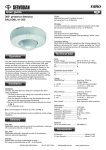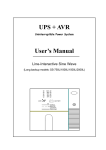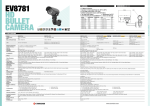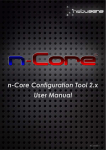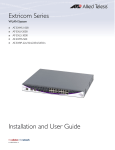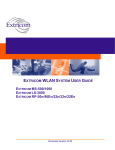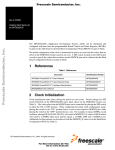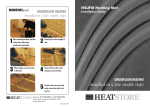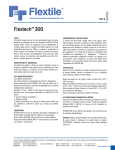Download Minilux Sensor PIR 360° Wireless 41-380
Transcript
Top view 2 Side view 2,5m 1 Minilux Sensor PIR 360° Wireless 41-380 C D A BCD D ø2 3m2 ø3,4 9m2 ø8 50m2 ø13,5 140m2 ø3 ø5 ø12 ø20 127 D ø3 7m2 ø5 19m2 ø12 110m2 ø20 300m2 0,8m A B C B A B C D A 7m2 B 19m2 C 110m2 D 300m2 3 A A+B+C 180° 315° Advarsel: Indbygning og montering af elektriske apparater må kun foretages af aut. elinstallatør. Ved fejl eller driftforstyrelser kontakt den aut. elinstallatør. ! Ret til ændringer forbeholdes ! Warning: Installation and assembly of electrical equipment must be carried out by qualified electricians. Contact a qualified electrician in the event of fault or breakdown. ! Reserving the right to make changes ! 41Y380_03_R0_090116KOE1211 Achtung: Einbau und Montage elektrischer Geräte dürfen nur durch Elektrofachkräfte erfolgen. Wenden Sie sich bei Störungen bzw. Ausfall an einen Elektrofachkraft. ! Änderungen vorbehalten ! Avertissement : L’installation et le montage d’appareils électriques doivent exclusivement être exécutés par un électricien agréé. En cas de défaut ou de perturbation du fonctionnement, contacter un installateur électricien agréé. ! Sous réserve de modifications ! Servodan A/S • DK-6400 Sønderborg Tel.: +45 7442 4726 • Fax: +45 7442 4035 www.servodan.dk • E-mail: [email protected] 1(10) 4A 4B 4C 230Vac L N 8 60 mm 24Vac / DC -+ L 230Vac N 24Vac / DC -+ Pozidriv (PZ) 0 / Phillips (PH) 1 5 7 230Vac L N 24Vac / DC -+ 230Vac L N 9A 24Vac / DC -+ LED1 230Vac LED2 LRN LED3 Sensor PIR 360° LED1 = Light + Movement LED2 = Movement LED3 = RF - Transmit Metal Ra 230Vac L N L 230Vac N Factory settings 24Vac / DC -+ 24Vac / DC -+ dio sh o ad w Receiver Receiver Visual contact 9B 24Vac / DC ON Factory settings OFF DIP 1 2 3 4 A) LUX - Test mode 41-380 41-380 6 DIP settings: PIR PIR 24Vac / DC 230V ac L N 1 2 = ON position 3 4 5 6 1 2 3 4 -- + 5 6 B) PIR - Test mode Sensor PIR 360° Effective wall thickness: 20 cm C) LED1/2 ON Effective wall thickness: 60 cm D) Min. sensitivity = OFF position Low attenuation D) Low sensitivity D) High sensitivity L + N -- Receiver High attenuation Receiver D) Max. sensitivity 2(10) GB Minilux Sensor PIR 360° Wireless 41-380 Fitting and operating instructions General: The Minilux Sensor PIR 360° 41-380 is a movement sensor based on wireless technology that sends an RF telegram to a receiver module, which switches the light on and off. 1st priority: Daylight 2nd priority: Movement · · · · · · · Areas of application: Small offices Open-plan offices divided into workgroups Premises with rest areas Shared activity rooms Changing rooms Large storage rooms Function: The integrated light sensor measures the light level in the area continuously, and compares it with the preset value specified via the LUX setting button. If the light level falls below the preset value and the movement sensor detects activity in the coverage area, the light is switched on. The integrated cut-out delay of 1...30 mins (adjustable) makes sure that RF switch-on telegrams are sent continuously (approx. once a minute) to the receiver, until the sensor does not register activity or the selected light level is reached. 1 Coverage area: The movement sensor is designed to be fitted to a ceiling. At a height of 2.5 metres the sensor will cover a floor area with a diameter of 20 m and provide full 360° coverage for movement of people. The sensor has a special lens area in the centre with a diameter of 5 metres, with more than 618 fields guaranteeing optimal detection of even very slight movements. The movement sensor is designed to be fitted to a ceiling at a standard height of 2.5 - 3.0 m, and is positioned over a desk, typically 1 m away from the seat. The sensor has a specially developed optical function with two detection ranges, a close range (A + B) to detect small movements and a distant range (C + D) to detect movement of people. This combination provides excellent control of lighting, while at the same time guaranteeing the best possible energy saving. 2 Limiting the detection range: f) 24VDC or ac is connected via the terminals labelled: -24V and +24V. If the coverage area is too large, it can be limited by fitting the enclosed cover. This enables the maximum range of 20 metres to be reduced to 12 metres, 5 metres or 3 metres in radius, and the angle of 360° can be reduced in increments of 45°. g) Power up causes an RF switch-on telegram to besent. The integrated indicator LED1 red or LED2 green will always be lit for 1 minute (stabilisation time). 6 Connection chart: 3 A 230Vac or a 24Vac/DC power supply is one option. This means that both may not be connected. Caution!: It is recommended that the PIR Sensor is not installed where it is exposed to direct sunlight, air flows from air conditioning, radiators, etc. With a view to achieving optimal transmission of the RF signal to the receiver, the PIR Sensor should not be fitted to premises with metal screening, which blocks signals between transmitter and receiver, please see the section on RF wireless information. 4 Installation: a) The ideal measurement of daylight is obtained by positioning the movement sensor with the light sensor facing the source of daylight. b) If the movement sensor is fitted directly to the ceiling, holes at intervals of 105 mm can be used. Please note that the cable input is turned 45° in relation to the fixing holes. c) If the movement sensor is fitted to a ceiling box, the holes located for this purpose at intervals of 60 mm are used, and the base opening is punched out. d) Neverfit the movement sensor to a metal panel, as this reduces the RF signal dramatically. 5 Connection: a) First read the WHOLE installation and user manual. b) Switch off all power during installation and setup. c) Note that the movement sensor can be connected to EITHER 230Vac OR 24Vac/DC. d) All assembly/cable laying must be undertaken correctly in accordance with the prevailing Installation Regulations. e) 230Vac is connected via the terminals labelled: L, N and the protective conductor to . 7 Setting up/testing: The movement sensor is supplied with two test mode functions, one for a LUX test a) and for a PIR test b). The chosen function is indicated with 2 LEDs, LED1 red for 1st priority: daylight or LED2 green to indicate PIR activity, as the only priority. LED1 and 2 – indication c). PIR sensitivity setting d) can be set in 4 different sensitivity positions. LRN button is a wireless system coding for the receiver, LED3 yellow indicates RF signal. By the means of the LUX setting daylight blocking can be deselected. LED1 red indicates 1st priority: daylight and PIR activation (Light + Movement). LED2 green indicates the only priority is movement and PIR activation (Movement). LED3 yellow indicates that the RF signal is being transmitted to the receiver. a) LUX TEST mode. Set the switches to DIP1 ON and DIP2 ON. In this position an RF switch off telegram is transmitted to the receiver module. Turn the LUX setting slowly from min. towards max. until the integrated indicator LED1 red lights up. At this point the LUX setting is identical to the daylight level measured by the sensor. If the daylight level in the room is sufficient, turn the LUX setting towards minimum until the LED is switched off, and leave the LUX setting at this level. If the LUX setting is turned towards min., the lighting is switched off at a lower daylight level. If the LUX setting is turned towards max., the lighting is switched off at a higher daylight level. Finish by setting the switches to DIP1 OFF and DIP2 OFF. b) PIR TEST mode. Set the switches to DIP1 OFF and DIP2 ON. In this position an RF switch-on telegram is transmitted immediately upon PIR activation and an RF switch-off telegram after 5 seconds, if there is no new activation. PIR activation is indicated via the integrated indicator LED1 red or LED2 green. PS: In this test the daylight blocking will not be working. Finish by setting the switches to DIP1 OFF and DIP2 OFF. c) LED1 and 2 – indication on. Set the switches to DIP1 ON and DIP2 OFF. In this position LED1 red will indicate PIR activity and that daylight blocking is selected; the PIR timer setting is adjustable from 1-30 mins. If daylight blocking is deselected (LUX setting at off position) LED2 green will indicate PIR activity; the PIR timer setting is adjustable from 10 sec....30 mins. We recommend that LED1 and 2 are switched off, by setting DIP1 and 2 to OFF, so that people do not feel that they are being watched. d) PIR sensitivity setting Switches DIP3 and DIP4 enable you to customise the sensor’s sensitivity. In the factory the product is set to high sensitivity. The options are described in fig. 7 . LRN button. If you press this button (learn), an RF status telegram will immediately be sent to the receiver, indicated via LED3 yellow. Must be used for system recognition of the receiver. PS: The receiver must also be set to “Learn mode”; please refer to the receiver’s description of the learning method. The PIR Sensor is preset in the factory as follows: • Sensor on automatic, with daylight blocking. • LED1 and 2 switched off. • High sensitivity. Deselection of daylight blocking. If the LUX setting is turned towards max. to the OFF position, the PIR Sensor will operate without daylight blocking. In this position the PIR timer setting can be adjusted to 10 sec….30 mins. 8 Assembling the sensor: a) Press the sensor part up into the terminal array in the base, and fit the Pozidrive (PZ)0/Philips (PH) locking screw. b) Set and test the sensor as described in fig. 7 . c) Reduce the coverage area as described in fig. 2 . d) Fit the Sensor’s cover. 5(10) Operation & maintenance RF signal distance/penetration: Make sure that the lens is kept clean and dry. The lens can be cleaned with a slightly damp cloth. In the event of faults or operational disruption beyond the normal user settings LUX, TIME, LRN, SENSITIVITY, contact an authorised electrician. Visible distance between transmitter and receiver: Typically 30 m in walkways, up to 100 m in large, open rooms, e.g. sports halls. Plaster/wooden walls: Typically 30 m distance through max. 5 walls. If there is no change, for every 100 event-controlled processes an RF telegram will be transmitted. Default setup of STM110 transmitter: T_wake up: 1, T_event: 100 T_send = 1 wake up x 100 event = 100 sec. Description of the RF telegram: 9 RF wireless information: The movement sensor has an integrated RF transmitter model STM110 (EnOcean). The RF transmitter signal has a frequency of 868 MHz, with a transmission rate of recurrence of 1x per 100 seconds, and a transmission output of less than 10 mW. This guarantees an RF environment that is typically 100 times less than conventional wireless systems. RF transmitter distance: As an RF signal involves electromagnetic oscillations/waves (of a certain field strength), these are suppressed on the way to the receiver. The RF signal’s field strength weakens proportionally by the square of the distance between transmitter and receiver. However, this natural reduction of the field strength as a function of distance is not the only suppression that affects the distance. Metal parts, e.g. in connection with reinforcements to wall and ceiling elements, metal foil in damp barriers or UV/colour filters through metal foil will all reflect, distort or suppress the RF signal on its way to the receiver. Below is a list (approximate) of penetration rates for commonly used building materials: Brick/aerated concrete walls: Typically 20 m distance through max. 3 walls. Steel-reinforced walls/ceilings (floor structures): Typically 10m distance through max. 1 ceiling/wall. The angle at which the RF signal hits the wall has an effect on the field strength. The ideal angle is a right angle. See fig. 9b . Fire walls, lift shafts and staircases. Should be treated as areas that cannot be penetrated by the RF signal. If there is any doubt, check the distance in the premises before securing to the building. Other sources of noise for wireless RF signal transmission: Devices that also operate using high-frequency signals, such as computers, audio/video systems, mobile phones, electronic transformers, connection units, frequency converters and other RF transmitters/receivers are all considered to be sources of noise for the wireless RF signal. We therefore recommend a minimum distance to such devices of 0.5 metres. EnOcean Profile: Profile 0b000111 – Occupancy Sensor Type 0b0000001 – Occupancy Sensor 1 Manufacturer ID 0b00000000011 DATA BYTES DB_1: PIR off PIR on DB_0.BIT_3: Learn button 0…127 128…255 0 = Teach-in telegram 1 = Data telegram For sensor using the previous EXMC coding, please refer to Sensor type 41-301 10 Technical data: Input: Supply voltage .......................... 230Vac ±10% 50Hz. Alternative supply ..................... 24Vac/DC ±10%. Inherent consumption .............. 230Vac – 1 W or 24V – 0.5VA. Performance: RF system transmitter .............. EnOcean STM110. Transmitter frequency .............. 868 MHz. Transmitter output .................... <10 mW. Transmitter rate of recurrence .... On standby once per approx. 100 sec. Immediately when PIR activation timer set. RF range ................................... 100 metres in open space/free line of vision, approx. 30 metres in buildings, see “RF wireless information”. Lux range .................................. 10…1000 Lux. Lux range off ............................. LUX is turned towards max to position off, no daylight blocking. Hysteresis ................................. > +10%. Cut-out delay ............................ 1...30 mins, with daylight blocking 10 sec.…30 mins, no daylight blocking. Sensitivity ................................. Selected manually. Activation indicator on/off ......... Selected manually. Test modes ............................... Selected manually. Protection class ........................ IP 20. Ambient temp. .......................... -5°C…+50°C. Cable bush ............................... 2 x Ø12 mm. RF transmitter rate of recurrence: The penetrative strength of RF signals: Materials Penetration Wood, plaster and glass without surface foil ........................ 90...100% Brick, MDF and chipboard panels ......... 65...95% Concrete reinforcement ......................... 10...80% Metal, aluminium panels, etc. ................ 0...10% In practice this means that the choice of materials in premises has a decisive influence on the distance between transmitter and receiver. As a guideline the following distances can be used. The movement sensor transmits an RF telegram as a function of an event-controlled process, but also in a fixed, time-controlled process. Measurement principle and telegram delivery: Approval: CE according to ........................ EN 60669-2-1 Note: The Sensor is marked with the EnOcean ID a) Delivery of an event-controlled process can take place by activating the button labelled “LRN”, which causes the internal microprocessor to start, the status of the movement sensor to be registered (activated or not) and an RF telegram to be transmitted immediately to the receiver. b) Delivery of a time-controlled process. At an interval 1x per 1 sec. (T_wake up) the internal microprocessor starts, the status of the movement sensor is registered, and if there is an activation an RF telegram is transmitted immediately. 6(10)





